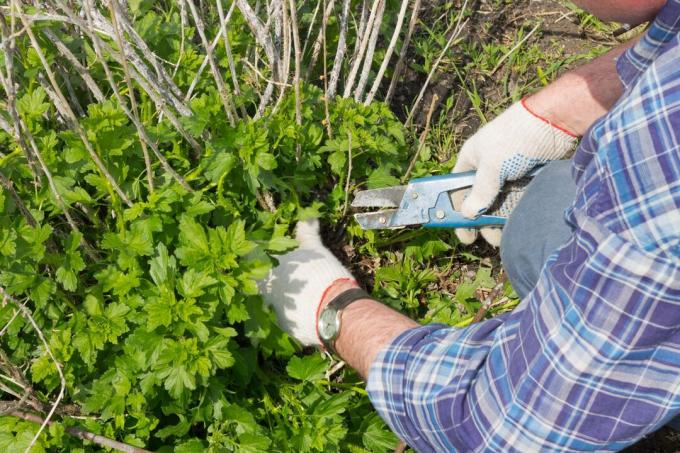Gooseberries live up to their name and cutting measures are all the more unpleasant. Nevertheless, a skilful cut of the gooseberry is always very good.

contents
- Cutting gooseberries: when to cut back?
- Cutting gooseberries: instructions
- Cut the gooseberry correctly as a high trunk or sapling
Cutting gooseberries: when to cut back?
While cutting gooseberries is generally not complicated, it is important to note that the timing is right. Otherwise, if you cut at the wrong time, you can expect a loss of yield.
When is the right time to cut gooseberries?
Gooseberries are usually cut after they are harvested. You can either do the pruning in autumn or wait until winter (until February). The latter has the advantage that the shrub no longer has any leaves and you get a better overview. In addition, to minimize the risk of infection for plant diseases, you should only make the cut in dry weather.

Tip: Of course, you shouldn't overdo it with cutting, so that enough fruit is left over.
Cutting gooseberries: instructions
The fruit quality, yield and growth rate of the gooseberry are regulated by the annual pruning. Annual side shoots bring the best yield - so you should get enough shoots from the main branch every year. When pruning the gooseberry, do the following:
- After all of the gooseberries have been harvested (and the shrub has run out of leaves), the first thing to do is to look at the older shoots. Gooseberries bear most of the berries on the young shoots. You should therefore remove low-yielding shoots that are more than four or five years old. You can recognize this by the dark wood and the stronger branching. Cut these shoots back to the point where they branched.
- Four to eight of the new fruit shoots are left (from the third year of standing). These should be at least as strong as a pencil and as flat as possible. Since only a certain section of the shoot bears flower buds, the length of the shoots also plays a role. The ideal length of the fruit shoots depends on the variety, but they should be shortened by at least half (up to two thirds).
- The leading branches should be renewed from the ground every three to six years, so replacement shoots should be used early enough. You should remove unneeded ground shoots.

Cut the gooseberry correctly as a high trunk or sapling
A tried and tested method of achieving high yields in gooseberries is to plant a standard stem. The cut is similar to that of a shrub, but is slightly different due to the shape. The best way to do this is to use a pair of loppers.
Every year in February, thin out the plant so that the individual branches do not rub against each other. Overhanging shoots are also removed. Cut back down to a few old and bald main branches. But always note that for an optimal yield, the new branches from the previous year must not be cut away. If this annual pruning has been forgotten for a longer period of time, the gooseberry also tends to shed. In this case, a radical rejuvenation cut is worthwhile, in which a large part of the main shoots is removed so that new shoots can grow again in spring.

If you'd like to learn more about how to make your Recycle the gooseberry harvest like here have the right article for you.
These products are ideal for cutting your shrubs, hedges and trees:- Felco secateurs: Manual pruning, pruning and pruning shears recommended for all types of cutting. In addition to plastic-coated handles, it has a precision adjustment system for the blade and anvil blade.
- Felco fruit tree and secateurs: Robust fruit tree and secateurs with wire cutter, sap groove and micrometer adjustment.
- Gardena telescopic arm scissors: Practical secateurs for effortless cutting of tall trees and dense shrubs from the ground.

Felco secateurs No. 11, red, 210 mm, 250g
43,46€
Details →

Felco fruit growing and secateurs No. 6
31,99€
Details →

GARDENA Telescope StarCut 410 plus
84,45€
Details →



